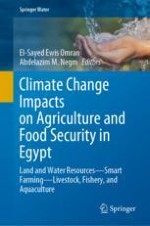This book gathers contributions discussing climate change in Egypt from an agricultural perspective. Written by leading experts, it presents state-of-the-art insights and the latest research developments in light of the most recent IPCC report. Focusing on identifying the specific phenomena that affect climate change in Egypt, the book also addresses the effects of climate change in Egypt, particularly examining the quality and quantity of water resources as well as the socio-economic impacts of climate change on agricultural activities. Furthermore, it explores alternative solutions to support agriculture and food security and raises awareness of adaptation and protection as the key to adapting to the risks posed by climate change.
Covering the four fundamental pillars of climate change: food security, availability, access and stability, this book is a valuable resource for stakeholders involved in achieving the 2030 sustainable development goals in Egypt and all countries with similar climatic conditions. It is also a unique source of information and updates on climate change impacts for graduates, researchers, policy planners, and decision-makers.
